|
FAQs about Limpet Snails, Acmaeidae,
Fissurellidae and more, Scutus, Stomatella
Identification 2
Related Articles: Gastropods, Sea Slugs, Mollusks, Abalone,
Related FAQs:
Limpets 1, Limpets 2, Limpets 3, Limpets
4, & Limpet Identification 1,
Limpet Behavior, Limpet Compatibility, Limpet Selection, Limpet Systems, Limpet Feeding, Limpet Disease, Limpet Reproduction, & Marine Snails 1, Marine Snails 2, Marine Snails 3, Marine Snails 4, Snail ID 1, Snail
ID 2, Snail Behavior, Snail Selection, Snail Compatibility, Snail Systems, Snail Feeding, Snail Disease, Snail Reproduction, Mollusks, Sea
Slugs, Abalone,
|
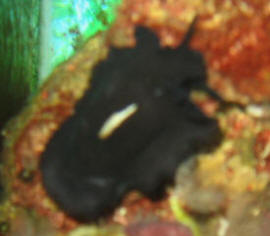
|
|
Stomatella or Scutus? 11/21/17
Hello wet web crew,
<Hey KL!>
I have looked over your site and read all your limpet and snail ID threads.
My main tank is 200 gallons with 75 refugium. Currently it only has crustaceans
and soft corals in it. Mainly mushrooms and a toadstool.
I found this critter in my tank tonight and wondering what it is.
Looks like a snail but only a small shell. Is it a snail or a limpet?
What species?
<Yikes... due to striations on the shell, and that it isn't white... will guess
a Stomatellid; but... could be either>
It's about 1 3/4 inch to 2 inches.
<The shell? Most Scutus top out at 12.5 mm>
Is it friend or foe?
<Friend; purposeful algae scraper>
I'm wondering if it felt safe to come out because there are no fish currently in
the tank.
<Likely arose from your live rock; common>
It moves pretty fast for a snail. I also have video if you want me to send it.
It's shell seems frilled or scalloped along the edges and I can't really tell if
its black or a translucent shell.
<Good points. Stomatellids typically have a mantle "tail" and are not
emarginated>
Thank you for any help you can offer.
KL
<I'd keep it. Cheers, Bob Fenner>
|
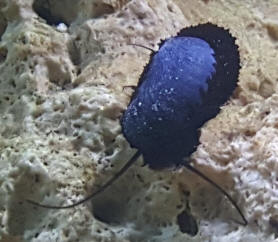 |
|
What is this? 1/7/14
I found this eating my star polyps.
<not>
Any idea what they are?
Linton
<Ah yes; Limpets... see WWM re. Bob Fenner>
|
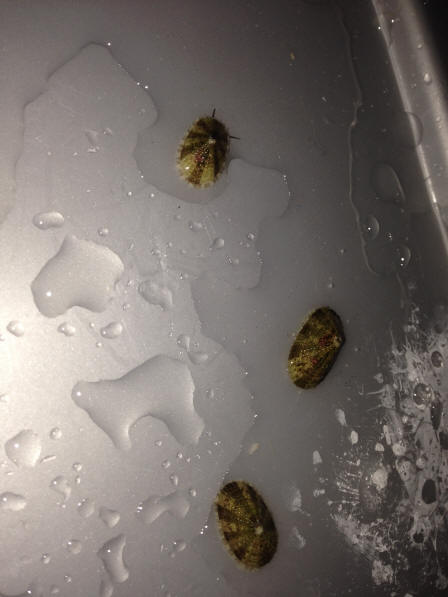 |
|
What are these? Likely Stomatellid - 1/29/13
Something eating my Zoas. I did find a sundial snail,
<Yikes, definitely remove it and keep an eye out for others.>
…but I have these slugs with a bluish back also. Should I yank ‘em?
<Hmm, well I’d need to see the top of the snail to be sure, but it appears
to be a harmless, Stomatella sp. of some sort. I would definitely
leave any of these in place as they’re beneficial herbivorous grazers that
reproduce easily in captivity. For more information, please enter the term
“Stomatellid” in our search engine:
http://www.wetwebmedia.com/Googlesearch.htm
More info here:
http://wetwebmediaforum.com/showthread.php?176-Critter-of-the-Week-Stomatella-nails&highlight=stomatellid
Hope that helps! Take care, Lynn Z>
|
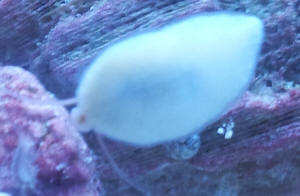 |
|
Snail I.D 12/26/12
I recently found this little mollusk crawling through my tank. As I was
unsure of what it was. I removed it from the tank for now. It is about
an inch long, flat(ish), and has a girdle of (skin or whatever) around
it. No hard outer shell is apparent but has two feelers at its head.
Please help.
<Mmm, there is a shell, internally... this appears to be a Scutus... see
here:
http://wetwebmedia.com/MolluscPIX/Gastropods/Prosobranch%20PIX/Limpets%20Scutus/LimpetF1.htm>
A harmless limpet. Bob Fenner>
|
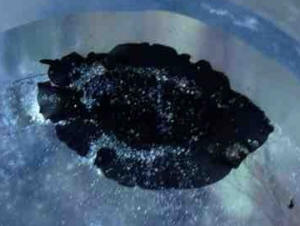
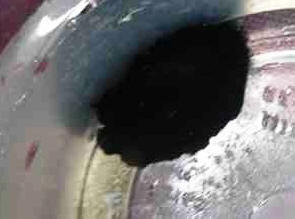
Re: Snail I.D 12/27/12
Thank you very much. Added the guy back to the tank.
<Ah good. BobF>
|
Keyhole limpet 6/8/12
Hi Crew, I had a pair of keyhole limpets
<The Ca. coast species, Megathura crenulata? In a chilled system?>
for 2-3 years and they died about 6 months apart. That was about 6 months
ago. I had babies that were smaller very tiny and the largest smaller
than a split pea. They are slowly getting larger. But lately I found
really tiny ones and am wondering how that could be. Are they so small
when first hatched that I would not notice them till now? Sam
<Mmm, yes... but I suspect what you're seeing is something else...
another similar appearing "limpet" sort of snail. Bob Fenner>
|
Help! Is this a turbo snail hitchhiker?
4/25/12
Hi there,
<Hi Rowan>
I've just introduced 2 turbo snails, 2 hermit crabs (one of which seems to
have died) and a sea urchin to my tank with my two clownfish. Today I
noticed one of my turbo snails seem to have a little hitchhiker on the
underside of its shell. The creature looks like another snail consisting
of a shell which it lifts every so often to poke out what seems to be
antennae
and occasionally it's mouth. I was lucky enough to get a fairly clear
picture which I have attached. Can you ID this creature? Should I be
worried about it? Does it need removing? I'm particularly fond of this
turbo snail and would be sorry to see it harmed.
<It appears to be a Limpet; a beneficial algae grazer. Read more here--
http://www.wetwebmedia.com/LimpetID1.htm >
Many thanks,
<Quite welcome>
Rowan
<Jordan>
|
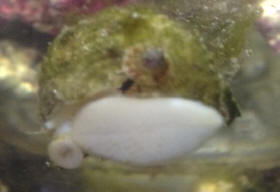 |
|
Can you ID this creature?
7/16/11
Let me preface by saying how wonderful you guys are! I own a reef
store in Las Vegas and tell everyone to check out the site.
<Ah, good to both>
I have a customer who brought me this cute little bug and would
like to know if he can keep him in his reef or not.
<Is a Limpet of some sort/species and should be fine w/ most
all one might have in a reef system>
His shell is hard and has the appearance of a scallop in shape
but it is more like a snail. In the second pic you can see his
little antenna sticking out from under his shell. Thanks in
advance.
<Please see here: http://wetwebmedia.com/LimpetID1.htm
and here: http://wetwebmedia.com/LimpetCompF.htm
Bob Fenner>
|
|
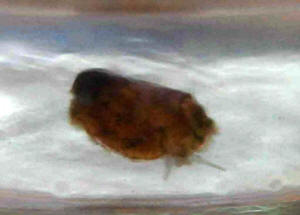 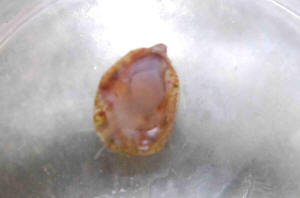
|
|
unknown snail ? 7/15/11
Hello to the crew,
<Howdy Rich>
One of the main problems with identifying unknowns is not knowing
what to search under, and running blind yields literally millions
of hits... so I'm hopeful that someone within the crew will
be able to point me in the right direction (please). This shelled
development of my tank was discovered during the recent tank
move. They appear to be only under the substrate (of course I
don't get a chance to night view for any length of time) and
measures about 1cm across at it's widest point. Sorry about
the quality of the side shot, but at least it's profile is
discernible. Any ideas of it's identity?
I thank you for your assistance,
Richard J.C.
<Mmm, would like to see the inside of the shell of a dead
specimen, but I think this may be a member of the Slipper Shells,
genus Crepidula, a calyptraeid. Bob Fenner>
|
|
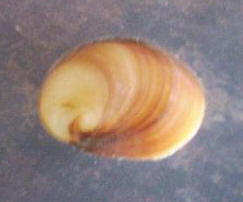 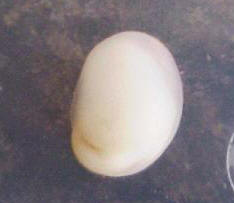
|
|
Unknown slug? 10/19/10
Greetings,
<Salutations>
I am new to the salt water hobby. I started my JBJ 24 gallon Nano
cube approximately 6 weeks ago. 20 lbs. of live sand and about 22
lbs. of live rock. I started my initial cycle with three damsel
fishes. Last water check at the LFS showed everything within
acceptable parameters and I am well on my way to completing the
cycle.
Over the last couple of days I noticed first one, then three
light brown slug type creatures who come out only at night when
all the lights are off.
last night I tried to grab one with the tweezers and it broke
itself in half, one half went in my dish and the other swam away
and hid. This morning, I located another, carefully removed it
and have attached the
photos to send to you.
It seems to be light brown in color with two long feeler type
projections at the front with two small stubby points in between.
it appears to have two black eyes at the front also with a very
small tube (mouth) off to the left. When it moves, the rear
appears to form two points, so from the top it kind of looks as
though it is pushing with the two back end pads.
I do not have any corals or invertebrates yet but plan on
purchasing these soon.
Should it stay or should it go?
<I'd leave it/them be... This is some sort of
snail/gastropod... likely related to Scutus, a limpet... family
Fissurellidae...>
Thanks - Roxane
<Welcome. Bob Fenner>
|
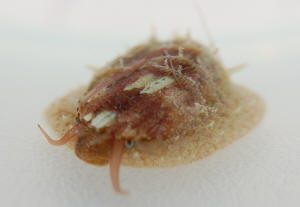 Nice pic! Nice pic! |
|
Re: Unidentified Goby, and Scutus...
5/5/10
Bob and Marco,
<Antoine>
That looks pretty spot-on (Eviota queenslandica) for a photo
match. I'll certainly let you know if he ever exceeds 2.4cm.
:)
Thanks and kind regards,
Anthony.
PS: I got another stowaway from the same batch of live rock, too.
I noticed this (a Scutus antipodes?) getting around the QT
tonight (must ask the LFS where they're getting their live
rock from)...
<Ah yes. Quite common. Good pix, ID. BobF>
|
_[793x250][1].jpg) |
|
Unknown Organism: Fleshy Limpet: Lucapina sp. --
4/6/10
Hello WWM,
<Hello JM, Lynn here today.>
Attached, please find a couple of photos of an organism I have
not been able to identify at WWM or elsewhere.
<What you have is commonly called a 'Fleshy Limpet', a
species of Lucapina in the Family: Fissurellidae. Basically,
it's a Keyhole Limpet that's able to extend its soft
tissue mantle over the entire external surface of the shell
instead of just skirting the outside edges.>
It is a little bigger than a quarter and always stays on the
live-rock.
<Yes, they seem to prefer hard surfaces -- rockwork, glass,
and such.>
It moves frequently but very slowly.
<Yep>
Any information or links regarding ID, origin and tankmate
compatibility would be much appreciated.
<Lucapina spp. mostly hail from the Western Atlantic, from
Florida all the way to Brazil, and the Caribbean. They seem to be
omnivorous, mostly grazing microalgae as well as small sessile
invertebrates from the rocks (sponges, hydroids, etc.). However,
I have read about, and seen photos of, some individuals consuming
coral tissue. It's not a given that this will happen with
your individual, though, especially if you have a mature system
with a lot of microalgae, etc., on which it can feed. Many
hobbyists have kept these, in systems with corals, with no
problems. Personally, I'd go with an innocent until proven
guilty theory and leave in place until/unless I saw damage, but
it's up to you. For more information, please see the FAQ
about half-way down the following link titled 'Orange Frilly
Limpet - Lucapina aegis':
http://wetwebmedia.com/LimpetID1.htm
The individual shown looks very much like yours, but
unfortunately, I can't find any other corroborating photos on
the web, or in my reference books, to positively confirm that
what you have is Lucapina aegis. Don't get me wrong, I'm
not disputing what Anthony Calfo has stated at all. I'm just
not personally comfortable offering a solid ID on a snail without
having seen the actual shell under the mantle, knowing where the
snail came from, and having multiple sources to back up the ID.
Complicating matters is the fact that these guys can vary in
mantle and shell color to a surprising degree. The only thing
I'm sure of is that you have a species of Lucapina. Is it
Lucapina aegis? It could very well be. What's important to
note is that in Mr. Calfo's response, he recommends removing
this snail, but again, it's up to you. Here's a link that
reportedly shows a live specimen of Lucapina aegis (mantle not
fully extended): http://www.jaxshells.org/aegis1.htm
Several live specimens shown at the bottom of this page (the last
one 'may be Lucapina aegis'):
http://z14.invisionfree.com/Conchologist_Forum/index.php?s=3d4adb02ec7886bb7914cf50fad8f838&showtopic=984&st=0&#last
Dr. Shimek's article (see Fleshy Limpet section about 2/3 way
down the page: http://www.reefkeeping.com/issues/2004-06/rs/index.php
More FAQs at WWM: http://wetwebmedia.com/LimpetID2.htm
Thanks in advance!
<You're very welcome!>
JM
<Take care, LynnZ>
|
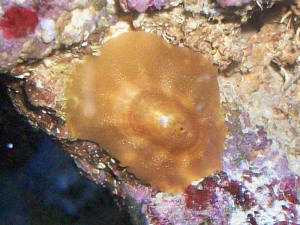 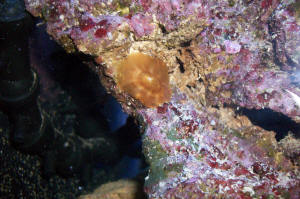 |
Re: Unknown Organism: Fleshy Limpet:
Lucapina sp. -- 4/6/10
LynnZ,
<Hi, JM!>
Thanks so much for that awesome and comprehensive response!!
<You're very welcome, it was a pleasure!>
I haven't noticed any bad behavior towards the rest of the
ecosystem so I am glad to say he stays.
<Yep, why not give the little fellow a chance? You can always
remove it later on if it starts nibbling on things it
shouldn't. In the meantime, you've got a nice little
algae-grazer and addition to the biodiversity of your
system.>
Thank again,
<Anytime>
JM
<Take care, LynnZ> |
|
Cap Snail ID: Batman is a Scutus! 4/5/10
<Hi Chris, Lynn here today.>
I have a cap snail in my tank that has doubled in size since
first noticing it about 4 months ago.
<That's a happy snail!>
It has been a joy watching it cruise the tank. We call him
"Batman".
<Heeee! Love the name!>
My question is "Can you identify it from the attached photo
and if so, how big will it get?"
<I sure can. 'Batman' is a species of Scutus, aka a
Ducksbill Limpet, Elephant Slug, etc., in the Family
Fissurellidae (Keyhole and Slit Limpets). They're mostly
algal grazers but apparently some do eat sponges. All in all,
they're beneficial/welcome additions to a reef system.
Regarding size, it depends on the species, but most have the
potential to get up to around 2' in length. There's a
species from Australia and New Zealand though (Scutus antipodes),
that can reach 5' in length. Now that's a big snail! For
more information, please see the following link:
http://www.seaslugforum.net/factsheet.cfm?base=scutus >
Thanks in advance,
<You're very welcome, enjoy Batman!>
Chris
<Take care, LynnZ>
|
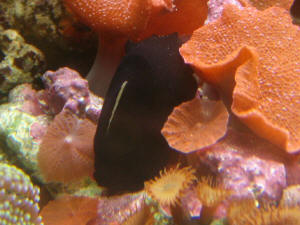 |
|
10/02/10 Dead Chitons.. No, Limpets!
Hi Simon,
<Hello Beth, how are you?>
My aquariums are doing fine at the moment, thanks to you.
<That's great news!>
Still having a few minor problems with alkalinity and calcium but
I am giving it one more water change before I try to address that
problem, again.
<Ok. Keep referring to the chemist-man RHF and you should make
it through!>
Right now, I am finding dead Chitons in the 20g tank. My big 1
1/2" Chiton is now just an empty shell and this past Sunday
I found another Chiton clinging to a rock with what looked like a
mucus net surrounding it.
<These are Limpets, not Chitons. They have a conical shell and
some have a hole on the top. Chitons are segmented.>
Could the mucus be a defensive mechanism of the Chiton or is it
what killed the Chiton?
<This has probably come from the Limpet itself when it died.
Did you not think you had a predator of these somewhere?>
It was Super Bowl Sunday and I promised my dad I would watch it
with him so I snapped a couple of pictures and ran out the door.
When I came home the next day, I found the empty shell of the
Chiton lying in the sand.
Any clue as to what is happening to the Chitons?
<I'm sorry Beth, apart from a predator and/ or water
chemistry I have no idea. Remember that these need balanced
calcium & alkalinity to build their shells. If these have
been 'off' for some time, on top of the other
problems that you have had, then that could easily explain their
deaths.
Maybe it has all just been 'too much'. Do be sure to test
to make sure that you do not end up with a 'cascade'
effect that affects your other creatures>
Thank You for your help,
<No problem at all>
Beth
<Simon>
|
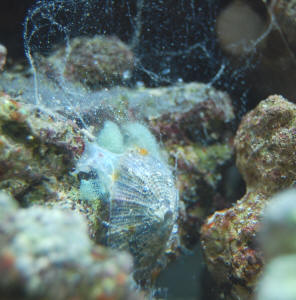 |
|
Help Me Identify This Snail: Stomatellid --
1/26/10
<Hello Nick, Lynn here today.>
I discovered this little guy crawling around the back corner of
my tank last night.
<Neat>
Any ideas on what it is and where it came from.
<It's a pretty little Stomatellid (probably Stomatella
varia) that most likely originated in the Western Pacific.
They're common, harmless/beneficial herbivorous grazers in
the family Trochidae. For more information, please see the
following links:
http://bb.wetwebmedia.com/viewtopic.php?f=25&t=181
Be sure to Google WWM for a veritable boatload of FAQ's re:
http://www.wetwebmedia.com/Googlesearch.htm
Photos of Stomatella varia:
http://www.gastropods.com/2/Shell_2422.shtml >
I had never seen it before. Thanks for all the info and service
you all provide.
<You're very welcome and thank you!>
Nick
<Take care, LynnZ>
|
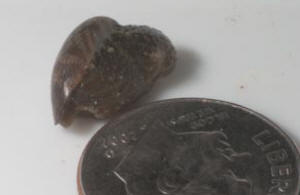 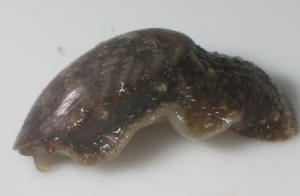 |
Help with identifying unknown snail?? Invert., SW...
1/25/10
<Hello Blaire, Lynn here today.>
I've had my aquarium for about 6 months now. About 2 months ago I
bought some live rock from someone who was parting out their tank.
Needless to say I brought in all sorts of new life forms.
<Neat>
There were a bunch of tiny pretty snails, pods, bristleworms, even some
neat looking mini anemones I couldn't identify that my Klein's
has since ate. (They weren't Aiptasia). There's one thing I
can't seem to identify though. It's about 3/4", slightly
more oblong than round, and very dark blue in color. If the light
isn't directly on it, it looks black. It does not have an actual
hard shell, and I can only say "snail" because it has a
snail's head with antennas. The "shell" is soft and
flexible (like the body of a ray), and it is very slow moving. I
can't really get a pic of it as I only see it a couple times a week
and it's always between rocks, never out in the open. Any help you
can give me would be greatly appreciated!
<Hmmm, there are many possibilities. An animal with antennae but no
visible shell could be some sort of sea slug, Nudibranch, Polyclad
flatworm, or even a Scutus unguis (aka the 'Ducksbill Limpet').
Soft and ray-like sounds more like a flatworm or some sort of slug or
Nudibranch, rather than a Scutus spp. but it's worth looking into.
Scutus unguis actually has a white shell, but it's usually covered
by the animal's deep black mantle. It's possible that under
certain lighting, the flexible black mantle could appear bluish.
I'm sorry I can't be more helpful but there are just too many
possibilities. Here are some links that will hopefully help narrow
things down a bit.
Nudibranchs: http://www.wetwebmedia.com/nudibran.htm
Sea Slugs: http://www.wetwebmedia.com/seaslugsopisthobranchs.htm
Polyclad Flatworms (see Pseudoceros sapphrinus):
http://www.wetwebmedia.com/WormPIX/FlatwormPIX/Flatworms2.htm
Scutus Unguis: http://www.seaslugforum.net/showall/scutus
Please let me know if you need any additional help. I know a picture
sounds impossible, but if you get lucky, send it along!>
Thank you, Blaire
<You're very welcome. Take care, LynnZ>
Re: Help with identifying unknown snail?? Scutus Unguis -
1/25/10
Hi Lynn,
<Hi Blaire.>
Thank you so much for your help!
<You're welcome!>
I looked it up and it's a Duckbill Limpet.
<Neat little creatures.>
All the little life forms that pop up are such treasures and I make it
a
point to find out what they are and what their needs are. Maybe you
could answer one more question for me? I have a Harlequin shrimp (what
a beauty!) and would like to know if there is anything I could add to
my tank that would dispose of the leftovers of the starfish he eats?
I've asked my LFS guys and they say my clean up crew should take
care of it but they don't. These little white pieces are adding up
quick and I can't get to them to siphon them out. Any
suggestions??
<If you don't already have hermits, I'd recommend getting
some Nassarius snails. They're terrific little scavengers that stay
hidden within the substrate then erupt en mass when they smell food.
They also have the added advantage of stirring the sand up a bit as
they move around. You could try either Nassarius vibex, a small species
(usually less than 1/2") or the larger (up to ~1') Nassarius
distortus, frequently called 'Super Tongan' Nassarius snails.
Both are commonly available on the 'net and elsewhere. Avoid any
snail sold as Nassarius obsoleta. It's actually Ilyanassa obsoleta,
a smallish brown snail that comes from cooler waters and lives
accelerated/shortened lives in the higher temperatures of our reef
systems. Another possibility, if you already have hermits (and you like
them), is to add a few more. I'm not a big fan because of their
tendency to pick at beneficial sessile livestock/fauna, rob corals of
food and occasionally kill snails but it's up to you. It just
depends on what you want to keep. Please see the following links for
photos of the various Nassarius species, as well as the Ilyanassa
obsoleta snail that you'll want to avoid!
Nassarius vibex: http://www.gastropods.com/0/Shell_1930.shtml
Nassarius distortus: http://www.gastropods.com/9/Shell_3309.shtml
Ilyanassa obsoleta: http://www.gastropods.com/5/Shell_3305.shtml
>
Thanks again, Blaire
<It was a pleasure. Take care, LynnZ>
|
Mollusk ID: It's The Incredible Mr. Limpet! --
1/21/10
Hi.
<Hello Beth, Lynn here today.>
I was wondering if you could help me figure out what this is.
<Fire away>
I have a 29 g tank that has been running for about 4 years. While
I was doing a water change, I noticed this little guy on a conch
shell (by the way my gold striped clown insists that the conch is
his anemone).
<That's a clown for you!>
I was hoping you could tell me what this is.
<It's a pretty little Keyhole Limpet, family
Fissurellidae. There are other similarly shaped Mollusks, but the
hole at the apex/top is the clincher. This opening, which is used
for expelling waste, can vary from round to distinctly keyhole
shaped, hence the name. Also typical is the arrangement of
concentric growth rings (often showing as different colors),
along with the strong radiating ribs/ridges that extend from the
shell's top/opening to the bottom edge. The almost rough
surface can sometimes be obscured by a growth of algae (usually
green or coralline), but doesn't harm the animal. The
feathery-looking protrusions you see on the soft tissue mantle
skirting the shell are called 'mantle tentacles', and are
sensory in nature. These neat little creatures are for the most
part harmless/beneficial herbivorous grazers but if the food
supply runs low, they can occasionally move on to soft corals or
large polyped stony corals. For example, I had Keyhole Limpets
for years in my tanks with no problems until one large individual
decided to munch on my favorite cherry red Blastomussa wellsi
polyps -- aaahh! Needless to say, he was ejected from the
display! That's the one and only problem I've ever had
with Keyhole Limpets. Personally, I'd leave your little
individual in place and enjoy it. For more information, please
see the many WWM FAQ's regarding. Just Google the term
Keyhole Limpet: http://www.wetwebmedia.com/Googlesearch.htm
Thanks so much for you help,
<You're very welcome. Enjoy Mr. Limpet!>
Beth Van Zandt
<Take care, LynnZ>
|
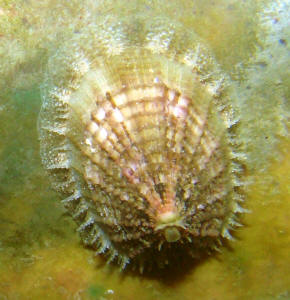 |
|
Baby snails...or something else? Probably something
else. 1-17-10
I've noticed these little snails in my tank a few months ago.
They were very small, just a tiny white dot. Now that they got to
an acceptable size I want to know if you could help me identify
them. <I can try!> I have a few Astrea snails in my tank
and Nassarius Tonga and Vibex. These little snails spend all
their time on the glass and don't hide during the day. What
worries me is that it started with 3 and now I have at least 25.
They don't seem to be bothering anything but I want to make sure
they are safe. I included a pic I hope it is clear enough.
<Unfortunately, no.> The biggest one I noticed the other
day is probably 1/4 inch. Hope you can help. Thank you very
much.( I read all the articles but could not find any positive
ID). <I'm assuming your attached photo shows the underside
of the animal attached to the glass. It doesn't look to be a
snail at all. My best guess points to most likely a Chiton, or
possibly a limpet. I can't give much other specifics without
a better photo. Maybe Bob can chime in with his
$.02.><<Do look like Limpets to me as well.
RMF>>
Brion
<Matthew>
|
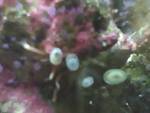 Full size pic Full size pic |
|
Re Baby snails...or something else?
Probably something else. 1/18/10
Thanks I know you tried your best. <You're very welcome.
If you want to send another photo of the critters in question, we
might be able to help out a bit more.> We took one out of the
tank to examine it better. It has a
hard cone shaped shell, some shells are black and some are tan.
The shell looks a little like a limpet like you said. <Limpets
are highly variable in nature. That's the best I could come
up with.> They have the 2 antennas that snails have and I can
see their mouths grazing the glass just like my Astrea snails.
Are all these common features of the limpets as well?
<Limpets do have antennae. I don't know too much about
them other than what they look like, unfortunately. Based on your
mouth and antenna description baby Stomatella snails are another
possibility. Do enquire via
a Google image search.> Sorry I couldn't get a better
picture. <Try, try again. Even out of the water might be
insightful.> Thanks at least I know they are safe and wont
harm anything. <Welcome. Matthew.>
|
|
Hoof limpet - 11/07/09
Hello,
I have attached a picture of what I believe to be Hipponicidae
sp. residing on the back of one of my snails!
<Looks like it!>
I have 'Googled' around and found some supporting
information but wondered whether this was a true example of
symbiosis
<Mmm, of a sort... I'd label this animal as a "space
parasite"... as the "host" appears to be harmed to
a degree, and definitely doesn't seem to benefit from the
Limpet>
or just an accident. The forked proboscis (if that's the
right term) extends significantly from the shell during feeding
as it picks around the areas that the snail is grazing so I
assume is diet is basically the same.
I not been able to narrow down to species level but suspect that
it is a harmless hitchhiker as the 'host' seems to be
unaffected.
<Mmm... I don't know... having something so large, heavy
on ones shell...>
I found it interesting and have not seen any similar pictures on
the web so wondered whether you would be interested too.
<Yes. Thank you for sharing>
Forgive my ignorance if it is actually common and I'm just
bad at web searches but if it is unusual I can think of no better
place to share it.
Your site has helped me a great deal over the years and continues
to be my favourite reference as the reliability and accuracy of
information here is in my humble opinion, above question.
Many Thanks,
Chris
<Welcome Chris! Bob Fenner>
|
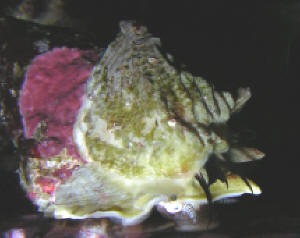 |
|
Yellow Mobile Unknown Hitchhiker 9/10/09
Hello,
<Howsit?>
I have a very colorful hitchhiker that showed up about 3 months
ago. It was smaller than a pencil eraser at that time but over
the months it has grown to about the size of a quarter. It does
move around on the rocks,
not very fast but fast enough to make me look for him every
morning and evening. He is circular and mostly flat, except in
the center. Looks to be a mouth but I'm just guessing at
that. I took a photo this evening and
as I was focusing, it spit out a white speck from the
"supposed" mouth.
Is this something beneficial or is it harmful to my reef
aquarium.
<More the former... I think this is the Limpet Lucapina aegis.
Bob Fenner>
Thank You
Beth
|
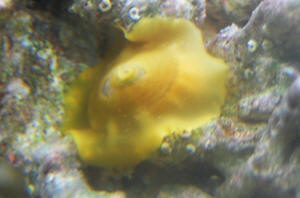 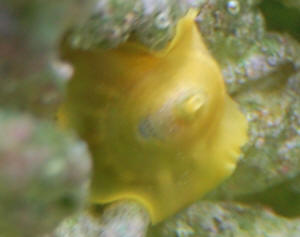 |
Re: Yellow Mobile Unknown Hitchhiker 9/10/09
Hello Again,
<Waking up now!>
After months of looking for the name of this hitchhiker, I
finally ask for assistance in identification and of course, in
the meantime, I keep looking for the answer. I used a different
search engine and different key words and I think that I found
the id. Is the answer Keyhole Limpet?
Thank You,
Beth
<A different Limpet (Thrummmm!). BobF>
Re: Yellow Mobile Unknown Hitchhiker
9/10/09
Morning Bob,
<And you Beth>
Grab a cup of coffee and wake up.
<Am trying>
Just got your note, I am assuming the "different
limpet" means that I have the wrong species?,
<Mmm, yes... but such are the dangers of common
appellations>
I was going to go with Fleshy Limpet but the information I found
states that these are Keyhole Limpets as well.
<"You say tomatoe"... Megathura is the genus of our
(Calif.) Keyhole...>
However, the information also states that they are about the size
of a shield limpet or smaller. I have a shield limpet and my
yellow limpet is much bigger than the shield limpet.
Of course you could be stating that it is just a unusual looking
limpet.
In which case, I totally agree.
I am getting conflicting information about limpets and cannot
decide if they are beneficial or harmful. Do you have any
thoughts about the benefits or harm that they can cause to coral
and or live rock?
Thanks Again,
<... Please read on WWM re such Archaeogastropods....
BobF>
Re: Yellow Mobile Unknown Hitchhiker
9/10/09
Morning Bob,
<Still?>
Please ignore last post. I read your response to my second post
and did not see your answer to my original inquiry until a few
minutes ago. Yahoo sent it to my Spam folder.
Thanks
Beth
<Velkommen! B>
|
|
Keyhole Limpet: Lucapina sp. --
1/17/09
<Hello there!>
I am trying to identify this keyhole limpet. It came from Florida
with an order from critters.
<Neat>
I can't find this particular one in any pictures.
<It appears to be what's commonly called a fleshy limpet,
in the genus Lucapina (possibly Lucapina suffusa). Please see the
photos at the following link for comparison:
http://z14.invisionfree.com/Conchologist_Forum/index.php?s=3d4adb02ec7886bb7914cf50fad8f838&showtopic=984&st=0&#last
I wanted to see if it is one of the bad ones.
<Fleshy limpets are not usually a problem in captive reef
systems. I'd leave it in place and enjoy! For more
information, please see the 'Limpets' section at the
following link. The last paragraph specifically relates to
Lucapina species.
http://reefkeeping.com/issues/2004-06/rs/index.php >
Any help would be greatly appreciated.
<You're very welcome. Looks like you've got a gorgeous
little limpet! Take care, Lynn>
|
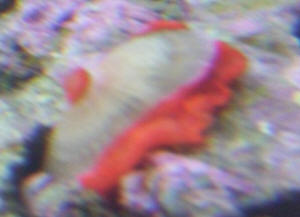 |
|
Identify- Fleshy Slug AKA Fleshy Limpet
10/22/08 Hello crew... <Hello Jessy here> I am
baffled by this ...shall I say....shell-less slug?? It moves all
over the tank sometimes on the glass but usually on the rockwork.
The first picture is very grainy but I wanted you to see it from
the front also and this was the best I had. Thanks in advance for
the help. <Donna, by my estimation that is a fleshy limpet.
See here for further ID
http://www.melevsreef.com/id/fleshy_limpet.html> Regards,
Donna
<Regards, Jessy>
|
[1].JPG) [1].jpg) |
| Reef Tank Newbie With Unknown Slug: Stomatella sp.,
Overcrowding Issues -- 8/27/08 Hi guys, <Hi there KC,
Lynn here this afternoon.> I have a 34 gallon Solana cube that
has been up and running for a little over three months now, one
month of which was spent cycling. It has approximately two inches
of live sand <Hmmm, please see this link for more information
regarding sand bed depth:
http://www.wetwebmedia.com/dsbdepth.htm> ..and about 30 pounds
of live rock. I am running a 250w MH SunPod lamp 10 hours a day and
have a CPR Bak Pak skimmer hanging off the side of the main
display. I also have the stock skimmer doing whatever it thinks it
is doing in the back sump. I wanted to move the CPR to the built-in
sump, but found out that the pump would not fit back there because
of the limited space even after removing the stock skimmer,
<Yep, that's frustrating all right.> so I thought it
wouldn't hurt to run both. <No, it could be redundant - but
that's not always such a bad thing! If the stock skimmer
isn't producing good skimmate (either in quality or quantity)
you could try running without.> The water readings are: calcium
-- 460 <Would let this fall a bit, to under 450. That is,
assuming that the numbers here are correct (the test kit's
reliable, not out of date). For more information regarding calcium,
please see this link (as well as related links at the top):
http://www.wetwebmedia.com/calcalkmar.htm> pH - 8.4 nitrate -- 0
phosphate - 0 alkalinity - (I use the Red Sea pH & Alk test kit
and it doesn't give a specific number for this. It has a color
chart that shows my water is in the "Normal Range - 1.7 -
2.8") <Not good -- you need specific numbers instead of a
range. I personally use/prefer Salifert for KH/alkalinity testing.
It's quick, easy to use, and most importantly, has a distinct
color change for better/more reliable results.> These are the
only things that I am testing for, should I be testing for more?
<Other than listing salinity/specific gravity, what you have
sounds fine to me. If you were having problems maintaining your
calcium level, I'd recommend a magnesium test kit, but that
doesn't seem to be necessary. Just keep in mind that if you
ever do consider adding supplements such as iodine/iodide,
magnesium, etc you'll need to first acquire those specific
kits. It's important to get a base-line reading as well as
monitor the levels as you increase them (not to mention making sure
they stay within recommended range thereafter.> I am still new
to this and am not too sure which elements I should be testing for.
<You should be good to go. Just be sure to keep up with regular
water changes. These make a big difference in helping to maintain
the extra supplements I mentioned (and more).> For inhabitants,
I have: 1 Fire Angel <I'm not familiar with this term.
I'm guessing it's a Flame Angel (Centropyge loriculus)? If
so, wow are they beautiful.> 1 Velvet Damsel 1 Three Stripe
Damsel <These damsels can become *very* aggressive, especially
in small/crowded systems such as this.> 1 Ocellaris Clown
<Would be nice to have a pair, but at this stocking point, I
wouldn't add one.> 1 Scooter Blenny 2 Fire Shrimp <These
are truly beautiful shrimp, if a bit shy (especially in systems
with strong lighting.> 1 feather duster <Can be difficult to
keep.> 1 2" Tridacna crocea <I would not have added this
until the tank was 6-12 months old at the very earliest.> 1
Turbo snail <Terrific herbivore.> 5 Margarita snails
<Unfortunately, these are cooler water snails that don't
live long in reef systems. The warmer water speeds up their
metabolism. It's a case of 'the candle that burns twice as
bright, burns half as long'.> 2 Cat Eye snails <These,
plus the Turbo listed above, have big appetites and will need a lot
of algae to survive. If there isn't a sufficient amount
existing in the tank, they'll starve to death. You may need to
supplement with dried seaweed/Nori sheets (available at most
regular grocery stores and Asian markets).> 10 or so hermits
<Hmmm, careful here. Hermits are neat, but many reef keepers
(like me) choose to avoid them. They tend to be opportunistic
little fellows that can cause trouble (picking at things, stealing
food from corals, killing small snails, even fellow hermits). This
is especially true when they're in high numbers, as is the case
here. It just makes for more competition for food. Keeping them
well fed, along with supplying plenty of (larger) empty shells,
will help deter (but not necessarily prevent) unwelcome
behavior.> 1 hammer coral 1 torch coral 1 small Acropora frag 1
plate coral a tiny patch of green star polyps that never come out
<Watch out. If/when these do come out, they can spread and take
over like you wouldn't believe. They'll even climb up the
sides of your aquarium. It's best to keep these separate and
away from your main rockwork so they can't spread and cause
problems.> a small rocks with a few Zoanthids on it 2 red
mushrooms <'Shrooms can also take over too, so watch
them.> 4 other bluish mushrooms that were given to me and I
don't know the names of. <Yikes, this is an overcrowded
tank, especially considering the fact that it's only 3 months
old! I would have skipped the Damsels, the Margarita snails, the
two 'Cat eye' snails, the feather duster, clam, and at
least 8 (or all) hermits. There's also a potential for serious
trouble down the road with the various corals you've listed. In
smallish systems such as this, you should really limit the variety
of species to those that will get along best in the long run.
Corals are like any other animal in that they'll fight to
ensure their survival. They do this in a variety of ways, including
chemical warfare or 'allelopathy' (for example many soft
corals/Gorgonians), direct contact with either sweeper tentacles
that sting (Euphyllids, like the hammer and torch coral you have
are particularly notorious for this) or mesenterial filaments that
digest the neighboring coral's tissues, or by simply
overgrowing (for example: green star polyps). Be sure to keep
enough space between the corals you have and move/remove as
necessary. I'd give the torch and the hammer corals at least a
6" buffer zone all the way around them, and keep an eye on
those green star polyps and mushrooms. Mushrooms (Actinodiscus),
although seemingly harmless, can sting adjacent, less aggressive
corals.> Each feeding, I soak the food in V3 Triple Strength.
The food alternates between flake, Cyclops-eeze pellets, krill, and
Mysis. For the corals, clam and feather duster, I dose DT's
live marine phytoplankton once every other day, and dose Marine
Snow once a week. <I'm not personally crazy about this last
product, but hey if it works for you! Just be careful with these
two additives and decrease if you notice excessive algae
production.> Unfortunately, I bought basically every inhabitant
in the tank before learning the error of buying prior to research,
and am trying to keep them healthy and correct errors I have made.
<Good for you.> Is my tank overcrowded? <Oh yeah.> When
I bought all the equipment, sand, and rock, the LFS told me to
cycle it for a month, which I did. Other than that, they happily
sold me whatever I wanted and I admit that I lost a rose tip
anemone and Nudibranch that they sold me not long after I bought
them. <Oh no. What a shame.> It wasn't until that point
that I started doing research on the internet about trying to keep
the rest of the inhabitants alive. I didn't want to lose any of
the remaining inhabitants and felt like a real jerk for losing what
I did. <Well, we've all made mistakes in this hobby. I know
I've made my share and then some! The important thing is that
we learn from them. In your case, it sounds like you just trusted
people that were either lacking in knowledgeable or that were more
concerned with selling their livestock (or both). The good news is
that now you know better. You know to always do your research
*before* purchasing. That combined with quarantining new livestock
will save many lives and much frustration.> That was when I
stumbled across your guys' site and have learned TONS of
invaluable information. <Excellent!> That was less than a
week ago, and it has already saved my Zoanthids from Zoa-eating
Nudi's. <Yikes!> I cannot thank you guys enough for your
wisdom! <LOL While I would never doubt the wisdom of Bob or my
fellow crew-members, the closest I personally come to being wise is
wisecracking!> My question: I have had a couple of these slugs
running around the tank and was not sure if it was harmful to a
reef tank or my inhabitants. <Nope, not at all. They're
absolutely harmless and beneficial.> I was wondering if you guys
could ID it for me. <Yes we can. Oh, you want to know what it
is! It's a species of Stomatella (possibly Stomatella varia), a
commonly seen hitchhiker that reproduces readily in tanks and is
frequently seen grazing film algae.> I tried to search through
your guys' vast resources, but I could not find what this slug
is, or if it is harmful to my reef tank. <No worries, it's a
good guy.> I might have missed it though in the ID section, as I
was trying to find it during work hours, but I was hoping you could
give me a hand. <Sure thing. For more information on Stomatellid
snails, please see the following link:
http://bb.wetwebmedia.com/viewtopic.php?f=25&t=181 Be sure to
also check out the many FAQ's regarding these neat little
snails at WWM. Just go to our Google search engine, and enter the
term Stomatella:
http://www.wetwebmedia.com/WWMAdminSubWebIndex/question_page.htm
> Thanks in advance, your site has really opened my eyes to
aquariums and I would have no doubt lost everything in a matter of
time if I didn't stumble across your Web site. Thanks again! KC
<You're very welcome! Take care, -Lynn> |
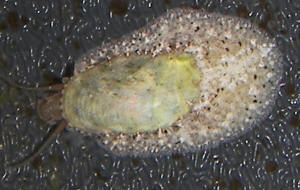 |
| Flatworm Or Nudibranch... Or Maybe Not... (Not)
-- 03/28/08 Hello guys, <<Adam>> I have an
interesting creature in my tank, I've read through the forums
and search across the Internet and I cannot get a positive ID on it
(Even checked the sea slug site you guys listed as a resource.).
<Okay>> It resembles a Nudibranch, although the one
picture I found of something that resembles it, you guys ID'd
it as a flat worm. (http://www.wetwebmedia.com/fltwmid.htm, second
picture from the top, question titled Nudibranch or Flatworm.)
<<Mmm, not a good picture is it? Regardless'¦what
you have is NOT a flatworm>> Flat worms are generally not as
large as this animal is, or at least I thought they weren't.
<<Some do get large>> The guy is around 2 - 2.5"
and only comes out at night, I have seen what seems to be
"antennae" protruding from it. <<Yes>> I
tried several different ways of taking the shot, one strictly with
LED's, others with flashes and/or an LED flashlight. I have
attached a few shots. <<I see them>> One peculiar thing
I witnessed last night was a split in the animals back.
<<Hee-hee! A clue!>> Down the center, which opened
slightly and receded when I placed the light over him. Any ideas?
<<Indeed'¦see below>> I am at a loss and
don't know whether to enjoy the little guy or eject him. I
monitored him for about an hour the other night when I saw him open
up down the middle and never really saw him feeding on anything and
he stays around a rock in the tank with Zoanthids, and a piece of
orange Monti. Only thing I could guess is filter feeding or feeding
off the worms and such in/on the rock. Thanks again, Adam
<<Well Adam, I've seen a couple of these before. What you
have there is Scutus antipodes (Black Limpet, Elephant Snail,
etc.). The 'split' you saw is where the mantel parted (the
mantel comes up from both sides to cover the shell on the animals
back). This critter is reputed by some to be reef safe...others to
be a Cnidarian muncher'¦but all seem to agree it's a
good algae grazer and a prolific breeder. Regards,
EricR>> |
|
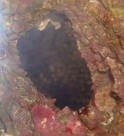
|
| No text? 1/8/08 <See... Stomatella...
BobF> |
|
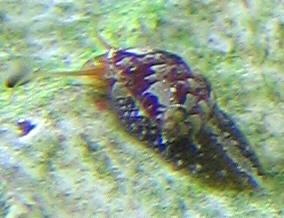
Re: ? Snail ID ayer 1/9/08 Bob -
<Joel... Oh there you are!> My apologies. I don't know
what happened to the content and subject line. I would not be so
rude as to intentionally do such a thing. I wrote an email
describing my tank setup and how much you and your crew have
helped me get 6 months into the hobby with nary a problem that
wasn't foreseen. Thanks for the response to what my question
was - "any idea what these might be, perhaps some sort of
Nudibranch?" I will read up on Stomatella now. Thank you
again. Regards, Joel Pippin <Looked like S. varia to me.
Cheers, BobF>
|
| Black Slug... actually is a snail... Scutus spp
12/03/2007 I found this in my tank and thought I would share
the photo. <Thank you for sharing!> I did some research and
found the slug to be (Scutus sp.) <Actually is a snail, not a
slug.> Order: VETIGASTROPODA Superfamily: FISSURELLOIDEA Family:
Fissurellidae. <Yes, more here:
http://www.seaslugforum.net/factsheet.cfm?base=scutus > Our slug
is about 2 1/2 inches and may grow to 5 inches in length. This is a
nocturnal slug and I found it by mistake a few weeks back. <Well
you found it nonetheless.> Just wanted to share. <Thanks
again!> Have a great day, Lis <Thanks Lis, you as well!
Mich> |
|
 Well done Mich/Mitch... RMF. Well done Mich/Mitch... RMF.
|
| Scutus pics 9/5/07 Hi, <Make me smile>
If there are any Scutus fans out there, here are some fun pics I
took of one of mine. :) Best, Sara <What did the Incredible Mr.
Limpet say? Thrum!!! BobF> |
|
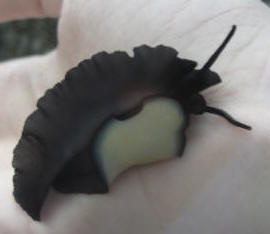 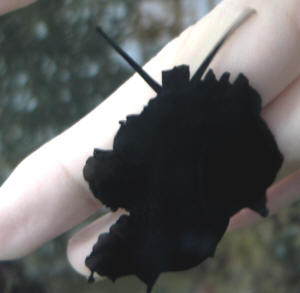
|
Limpets A year ago I noticed two limpets in my aquarium. It
is a 90 gallon (6'x1'x2'). My guess is they came in on the
live rock I added 7 months before. The curious thing is this. It took 7
months to see the first 2, and I now have roughly 100 more. They are
black with a white stripe on their back and are actually not
unattractive despite their numbers. They do a good job keeping the
glass, and everything else, clean. They range in size from 1/4 inch to
1 1/2 inch and are found everywhere from the skimmer collection cup
(always a few small ones on the cup of a CPR Bak-Pak), to the live
rock, to the glass. I have about 80 pounds of Fiji live rock, a 1 inch
aragonite sand bed, the CPR, and a couple Hagen 802's for
circulation. I also have Naso, yellow, and regal tangs (1 of each--all
about 3.5 inches), a coral banded shrimp, a false percula clown, and
about a dozen snails and small hermits. There are no corals or
anemones. Ammonia and nitrites are 0. Nitrates are close to 50. S.G. is
1.024. Temp. is 76 and pH is 8.0. I add no chemicals and have 0 algae
other than coralline which covers most everything and has to be scraped
from my glass at least every two weeks. I have two questions. First, is
this an extremely unusual occurrence? In order to identify these things
I had to post pictures to a newsgroup since the few inexpensive books I
have don't even mention them. Second, I'll be adding a dwarf
lionfish and snowflake moray to the system tomorrow. Will either/both
decide to make a feast out of the limpets? If they do, it would
probably be good for them, since, in their numbers, I think the limpets
would be able to sustain enough of a population to meet their dietary
requirements. By the way, when I first set up this system roughly two
years ago, I dosed Kalkwasser for about 2 months to try and get the
coralline to grow, and it didn't. Ever since, I have added no
chemicals (other than synthetic salt and frozen food for the fish) to
the aquarium, and the coralline is almost out of control. It's a
great problem to have. By the way, I have 6 24" fluorescent bulbs.
Four were bought at home depot (cheap bulbs), while the other 2 are
actinic. I also have a large population of feather dusters growing out
of the rock and some have even built tubes of up to 2 inches and are
living in the sand bed. Is this extraordinary luck, or did I
accidentally hit on the aquarium conditions that the worms, coralline,
and limpets thrive in (i.e., low light and not-so-low nitrate)? If my
experience is unusual, I'll probably try to replicate the
environment (minus the fish) in a 29 gallon, devote some study to all
three, and write a paper detailing the conditions for anyone that might
want to duplicate them (though their suitability would be limited to a
fish only situation). Any guidance would be appreciated. Thank you in
advance for your time. Sincerely, Richard Weatherly >> Wow, what
an outstanding query, relating of experience and uplifting story...
Congrats to you. And I think you may be on the verge of a great
commercial success. I have only seen a few cases where the snails
called limpets were so abundant as yours... and they are a blessing...
And your lion and eel will not consume them (different diets all the
way around), but I would do as you say, and save some of these
"Chinese Hats" in another system... if for no other reason,
for just safekeeping. And do "share the wealth" and supply
some to fellow hobbyists... Your relating of the non-supplement use and
results is exemplary by the several meanings of the term... Thank you
for writing... please do consider tallying up your observations and
sending them to one of the hobby magazines... Very useful. Bob
Fenner
|
|

